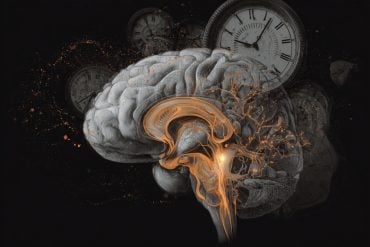Summary: Study reveals social learning via oral communication or video can affect human behavior and decision making just as strongly as personal experience. The findings shed light on why people may sometimes make irrational decisions.
Source: Karolinska Institute.
Learning what is dangerous by watching a video or being told (known as social learning) has just as strong an effect on our decision-making as first-hand experience of danger, researchers at Karolinska Institutet in Sweden report. The results of the study, which is published in the journal PNAS (Proceedings of the National Academy of Sciences), can help to explain why we take irrational decisions.
It is easy nowadays to be exposed to unpleasant and threatening information, with accidents, terrorist attacks and natural disasters appearing, for instance, on TV, digital news sources and social media. Previous research has shown that individuals who have long exposure to news reports of a terrorist attack can develop psychological problems as serious as those afflicting people who experienced it first-hand. However, just how our actual behaviour is affected by such indirect learning of danger has remained unknown.
This has now been laboratory tested in a study conducted by researchers at Karolinska Institutet, University of Amsterdam and University of Zurich. The study shows that threat learning via video or orally can affect human behaviour just as strongly as personal experience.
In the study, three groups of participants, totalling 120 individuals, initially learnt which of two neutral images was “dangerous”. The first group learnt through direct experience of an electric shock, the second by watching a film of someone receiving electric shock when looking at the image, and the third by being given oral instructions on which image to associate with an electric shock. In other words, the participants in the social learning groups (observation and oral instruction) suffered no actual physical discomfort.
The participants were then asked to repeatedly choose between the two images. Their choice could result in an electric shock, their task being to receive as few shocks as possible.
For half of the participants, the choice of image that was “dangerous” during the first part of the experiment entailed the highest risk of electric shock. This meant that their previous learning was relevant to their decisions. For the other half, the choice of image that was not “dangerous” in the initial stage entailed the highest risk of shock. This meant that their previous learning was wrong.
What the researchers found was indirect social learning (watching a film and oral information) had just as strong an effect on the participants’ decisions as learning by first-hand experience. Participants who had learnt that a certain image was “dangerous” continued to avoid it, even though their choice resulted more often in an electric shock.
“The study suggests that these social ways of obtaining information can strongly influence our decision-making, even to our own detriment,” says lead author Björn Lindström, researcher at Amsterdam University and the Department of Clinical Neuroscience, Karolinska Institutet.

“The results can help us understand why people behave irrationally,” says research group leader Andreas Olsson, senior lecturer at the Department of Clinical Neuroscience, Karolinska Institutet. “They indicate that it can depend on something we’ve learnt by watching a video clip or listening to a rumour that’s misleading for the environment in which we find ourselves.”
The researchers also used computational models to show that the two types of social learning influence behaviour through different learning mechanisms, possibly reflecting differences in underlying brain systems. Brain activity was not measured in the study, however.
Funding: The study was financed by the Knut and Alice Wallenberg Foundation, the Bank of Sweden Tercentenary Foundation, the European Research Council, the Swedish Research Council for Health, Working Life and Welfare (Forte), the Swedish Research Council and the Swiss National Science Foundation.
Source: Karolinska Institute
Publisher: Organized by NeuroscienceNews.com.
Image Source: NeuroscienceNews.com image is in the public domain.
Original Research: Open access research for “Social threat learning transfers to decision making in humans” by Björn Lindström, Armita Golkar, Simon Jangard, Philippe N. Tobler, and Andreas Olsson in PNAS. Published February 13 2019.
doi:10.1073/pnas.1810180116
[cbtabs][cbtab title=”MLA”]Karolinska Institute”Social Threat Learning Influences Decisions.” NeuroscienceNews. NeuroscienceNews, 15 February 2019.
<https://neurosciencenews.com/social-threat-decisions-10749/>.[/cbtab][cbtab title=”APA”]Karolinska Institute(2019, February 15). Social Threat Learning Influences Decisions. NeuroscienceNews. Retrieved February 15, 2019 from https://neurosciencenews.com/social-threat-decisions-10749/[/cbtab][cbtab title=”Chicago”]Karolinska Institute”Social Threat Learning Influences Decisions.” https://neurosciencenews.com/social-threat-decisions-10749/ (accessed February 15, 2019).[/cbtab][/cbtabs]
Abstract
Social threat learning transfers to decision making in humans
In today’s world, mass-media and online social networks present us with unprecedented exposure to second-hand, vicarious experiences and thereby the chance of forming associations between previously innocuous events (e.g., being in a subway station) and aversive outcomes (e.g., footage or verbal reports from a violent terrorist attack) without direct experience. Such social threat, or fear, learning can have dramatic consequences, as manifested in acute stress symptoms and maladaptive fears. However, most research has so far focused on socially acquired threat responses that are expressed as increased arousal rather than active behavior. In three experiments (n = 120), we examined the effect of indirect experiences on behaviors by establishing a link between social threat learning and instrumental decision making. We contrasted learning from direct experience (i.e., Pavlovian conditioning) (experiment 1) against two common forms of social threat learning—social observation (experiment 2) and verbal instruction (experiment 3)—and how this learning transferred to subsequent instrumental decision making using behavioral experiments and computational modeling. We found that both types of social threat learning transfer to decision making in a strong and surprisingly inflexible manner. Notably, computational modeling indicated that the transfer of observational and instructed threat learning involved different computational mechanisms. Our results demonstrate the strong influence of others’ expressions of fear on one’s own decisions and have important implications for understanding both healthy and pathological human behaviors resulting from the indirect exposure to threatening events.







